#galloanserae
Text
Lavanttalornis hassleri Bocheński et al., 2023 (new genus and species)
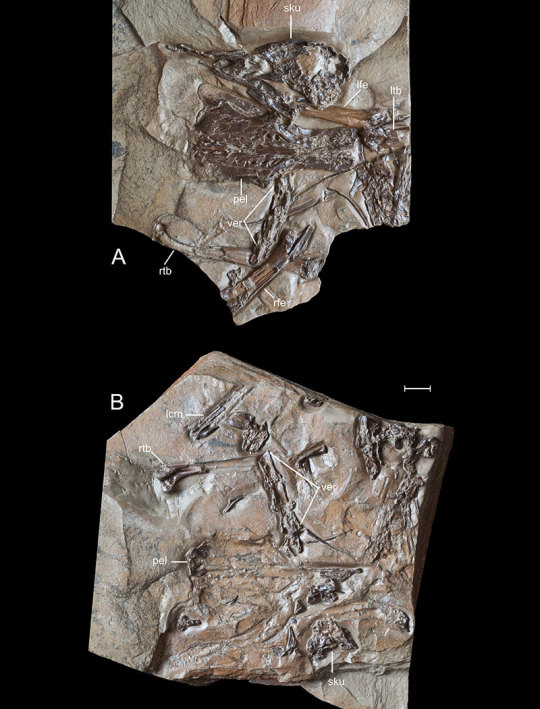
(Type specimen of Lavanttalornis hassleri [scale bar = 10 mm], from Bocheński et al., 2023)
Meaning of name: Lavanttalornis = Lavanttal valley bird [in Greek]; hassleri = for Andreas Hassler [discoverer of the original fossil]
Age: Miocene (Serravallian), around 12 million years ago
Where found: The Lavanttal, Carinthia, Austria
How much is known: Nearly complete skeleton of one individual.
Notes: Lavanttalornis was a duck, and one of the most completely known Miocene ducks yet found. Details and proportions of its limb bones suggest that it primarily fed by dabbling (collecting food on or just below the water's surface) instead of diving underwater, but it is unclear which group of modern ducks it was most closely related to.
Reference: Bocheński, Z.M., J. Happ, G. Salwa, and T. Tomek. 2023. An intriguing new species of dabbling duck (Aves: Anseriformes) from the middle Miocene of Austria. Palaeontologia Electronica 26: 52. doi: 10.26879/1334
143 notes
·
View notes
Text
Fossil Novembirb 4: The Megafowl

By @thewoodparable
One of the *most* iconic dinosaurs of the Cenozoic has got to be Gastornis, often referred to as "Diatryma", the giant fowl of the Early Paleogene. This animal first appeared between 60 and 56 million years ago in Europe, and spread to Asia and North America during the earliest Eocene. In the hot temperatures of the Paleocene-Eocene Thermal Maximum, it even lived up in the Arctic Circle, in the Tropical Polar Forests of the period. This single genus lasted a while, living until the middle Eocene, around 45 million years ago.
Gastornis is most famous due to its size, growing as tall as 2 meters height and up to 175 kilograms in mass. This made it one of the largest birds known, with a giant head and extremely tall beak. The skull itself was very powerfully built, with the beak compressed and lacking the raptorial hook of the later appearing terror birds.
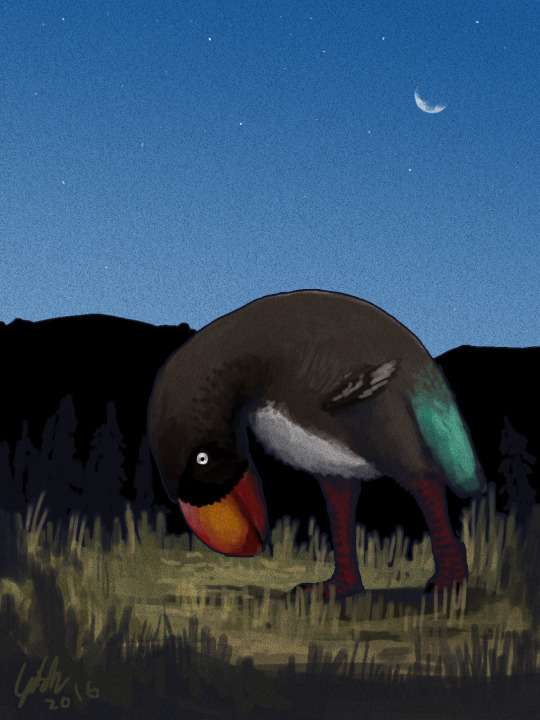
By Ashley Patch
This is important to note, because for a long time - until 2014, really - we thought Gastornis was a predator. Turns out, however, it was an herbivore, probably feeding on a generalistic diet of plants similar to other macroherbivorous dinosaurs. In fact, not only did it not have a predatory beak, but footprints that are probably from Gastornis suggest it did not have talons or raptorial feet adapted for hunting, either.
Feathers of Gastornis are not definitively known, however, a feather impression from the Green River Formation may be that of Gastornis due to its large size, and resembled feathers found on flighted birds, rather than the shaggy feathers of ratites. This is notable, as it seems that Gastornis was closely related to the "Fowl", aka Galloanserae, rather than the modern flightless ratites of today. Whether it's closer to ducks or to chickens is a question, hence the generic moniker of "Megafowl".
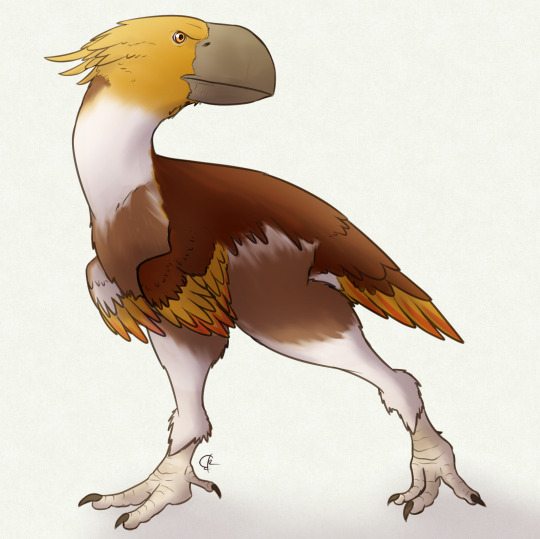
By @quetzalpali-art
Why did Gastornis go extinct? The answer is unclear. It seemed to have disappeared from North America and Asia at the end of the early Eocene, possibly due to the dropping temperatures. It persisted in Europe for longer, which was isolated at the time and may have thus been more habitable for Gastornis. That said, there is some evidence that the Mihirungs of Australia - who we'll get to know later - are related to Gastornis, and they are found in the Oligocene to Pleistocene of Australia - so maybe Gastornis didn't go away quite as soon as we thought!
Unfortunately, the behavior of this dinosaur is not particularly well known - it's uncertain if it lived in groups, how it nested, or what its foraging method would have been, as there are no living animals similar to it. Hopefully, more fossils of Gastornis will paint a clearer picture of the Megafowl of the Paleogene.
Sources:
Mayr, 2022. Paleogene Fossil Birds, 2nd Edition. Springer Cham.
Mayr, 2017. Avian Evolution: The Fossil Record of Birds and its Paleobiological Significance (TOPA Topics in Paleobiology). Wiley Blackwell.
179 notes
·
View notes
Text

With recent advances in genetic sequencing and analysis, we now have a pretty good idea of how most modern vertebrate animals are related to each other. One of the biggest remaining mysteries in vertebrate evolution (and a major theme of my own research), however, is the relationships among the major groups of living birds.
There are some things that we all agree on about the bird family tree (which in some cases were already recognized before the rise of genetic studies), a big one being that modern birds can be divided into two major branches: Palaeognathae (ostriches, emus, and their close relatives) and Neognathae (all other living birds). Neognathae is in turn divided into Galloanserae (chickens, ducks, and their close relatives) and Neoaves (all remaining birds, which constitute 95% of living bird diversity).
Despite birds being one of the most intensely studied animal groups, however, essentially none of the large-scale genetic analyses that have been done on them so far have agreed with each other regarding how the major groups within Neoaves are related.
A new study by Stiller et al. (2024) might represent a big step forward in solving this mystery. Their results suggest that Neoaves can be divided into four major groups.
Mirandornithes: Flamingos and grebes. Stiller et al. found that all other members of Neoaves are probably more closely related to each other than to this group.
Columbaves: Consisting of two major subgroups, Otidimorphae (cuckoos, bustards, and turacos) and Columbimorphae (pigeons, sandgrouse, and mesites). Notably, Columbimorphae has been found by some earlier studies to be more closely related to Mirandornithes, but a second paper that was published on the same day by some of the same authors as Stiller et al. (2024) reported evidence that this previous result was probably caused by misleading similarities between the genetic sequences of Columbimorphae and Mirandornithes.
Elementaves: Consisting of Gruiformes (cranes and their close relatives), Charadriiformes (shorebirds), Strisores (hummingbirds, swifts, nightjars, and their close relatives), Phaethoquornithes (many waterbirds, including penguins, albatrosses, and herons), and the engimatic hoatzin. The exact relationships among these groups are still somewhat unclear; for example, Stiller et al. found the hoatzin to be most closely related to gruiforms and shorebirds (as had been suggested by an earlier study), but support for this result was not high. The hoatzin remains the single most difficult bird species to place in the bird family tree. The name Elementaves was newly coined by Stiller et al., referring to the fact that this group includes species specialized for life in the water, on the ground, and in the air (corresponding to the classical elements of water, earth, and air), as well as birds named after the sun ("fire"), such as the tropicbird genus Phaethon (Ancient Greek for "sun") and the sunbittern. This means that there is now a scientific basis for parodying Avatar: The Last Airbender using birds.
Telluraves: A big group consisting primarily of tree-dwelling birds, including songbirds, parrots, woodpeckers, kingfishers, and the various groups of birds of prey. An interesting result found by Stiller et al. is that owls are likely closely related to accipitrimorphs (hawks, eagles, vultures, etc.), which not all previous genetic studies had supported.
Stiller et al. (2024) provide further evidence for some bird relationships found by earlier analyses, but their results still doesn't exactly match those of any single previous study, so what makes this different from all those attempts that came before it? One is the amount of data. The genetic dataset analyzed by Stiller et al. was many times larger (both in terms of sequence length and the types of genes examined) than any study of this sort that had previously been done on birds. They also included over 360 bird species, which is more than what most previous studies had. Furthermore, they ran numerous tests to determine how the amount of data, number of species, and types of genes analyzed affected their findings, and in doing so were able to show that most of their results were relatively robust, or at least better supported than alternative hypotheses.
Another point of contention regarding the evolution of Neoaves is when the group originated. Were there already many neoavian lineages around during the Late Cretaceous, or did they mostly diversify following the mass extinction event that ended it? In the 2000s and early 2010s, studies trying to estimate the ages of bird groups based on rates of genetic evolution tended to find an older origin for Neoaves, but the majority of newer studies favor a younger origin, with most or all modern neoavian groups appearing after the Cretaceous (though one paper from earlier this year by a different team of authors advocated for older ages). Informed by recent studies on fossil birds, the results of Stiller et al. add further support for a more recent, mainly post-Cretaceous diversification of Neoaves (which I happen to think is more plausible than deep Cretaceous origins).
This almost certainly won't be the last word on these controversies by any means. However, at the moment I'm willing to tentatively consider Stiller et al. (2024) the closest we've gotten to approximating the true family tree of birds, and that is not a declaration I'd make lightly.
18 notes
·
View notes
Text
Phylum: Chordata
Subphylum: Vertebrata
Class: Aves
Infraclass or superorder: Paleognathae or Galloanserae
5 notes
·
View notes
Text
Myles Fowl *pointing at Artemis* - This is my older brother, Kylometre Galloanserae
9 notes
·
View notes
Text

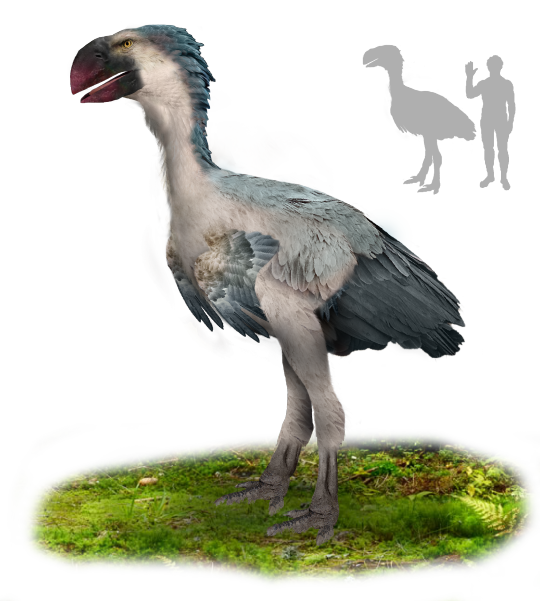

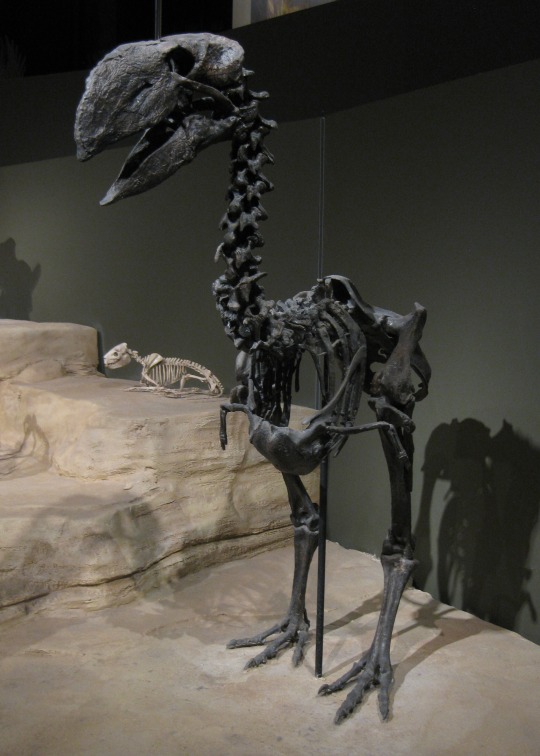
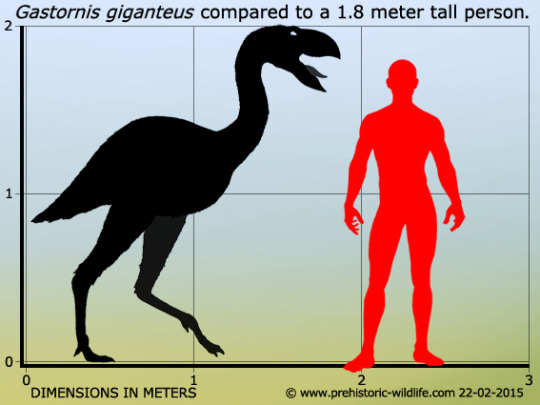
Gastornis
(temporal range: 61.6-41.2 mio. years ago)
[text from the Wikipedia article, see also link above]
Gastornis is an extinct genus of large flightless birds that lived during the mid Paleocene to mid Eocene epochs of the Paleogene period. Fossils have been found in Europe, Asia and North America, with the remains from North America originally assigned to the genus Diatryma.
Gastornis species were very large birds, and have traditionally been considered to be predators of small mammals. However, several lines of evidence, including the lack of hooked claws in known Gastornis footprints and studies of their beak structure and isotopic signatures of their bones have caused scientists to reinterpret these birds as herbivores that probably fed on tough plant material and seeds. Gastornis is generally agreed to be related to Galloanserae, the group containing waterfowl and gamebirds.
9 notes
·
View notes
Text
metazooa dot com
first of all its frankly impressive that i remember to do it with 43 mins left until the new one...

[ID: Metazooa, a cladistics puzzle tree, guessed in seven, with few 'wasted' guesses. from human in amniota, sea snake in sauria, crocodile in archosuaria, crow in neognathae, duck in galloanserae, turkey in phasianidae. Correct answer, peacock, also in phasianidae. END ID]
JUST FEELS SO SASITISFYING. i am the master of this animal guessing game. it honestly feels better this way than solving it in fewer....
5 notes
·
View notes
Note
Huh, so do you know anything about what makes birds so hard as opposed to other groups?
(context: bird hell)
I would guess something about fossils being hard to find? But seriously though at this point I'm just guessing based on Wikipedia talking about discovering new fossils since the 1980s letting us split Neognathae into Galloanserae and Neoaves, which cites "Mindell & Brown (2005)" which I can't find anywhere. :(
0 notes
Text
Recipe for Aartis Easy Tandoori Chicken
Making the perfect Aarti’s Easy Tandoori Chicken should only take approximately 2 hr 30 min . It’s considered an Easy level recipe. Below are the ingredients and directions for you to easily follow. The Aarti’s Easy Tandoori Chicken recipe can feed your family for 2 servings.
There are many different ways to make this Aarti’s Easy Tandoori Chicken recipe. Once you’re familiar with our recommended ingredients and directions, you can add your own twist to this recipe to make it your own! We’ve also listed potential Cookware items below that might be necessary for this Aarti’s Easy Tandoori Chicken recipe.
Aarti’s Easy Tandoori Chicken Popular Ingredients
2 boneless, skinless chicken breasts
2 cups Aarti’s Tandoori Marinade, recipe follows, divided
1 tablespoon vegetable oil
1 teaspoon honey
4 cups mixed salad greens
Olive oil, to taste
Lemon juice, to taste
Kosher salt and freshly ground black pepper, to taste
2 chiles de arbol
3 tablespoons fenugreek seeds
1 tablespoon coriander seeds
5 cloves
Seeds from 4 green cardamom pods
Seeds from 1 black cardamom pod
3 tablespoons paprika
1 teaspoon ground cinnamon
8 cloves garlic
1 (2-inch) piece fresh ginger, peeled
4 cups plain yogurt (recommended: full fat)
1/2 cup peanut oil
Juice of 2 limes
Kosher salt and freshly ground black pepper
Steps for making Aarti’s Easy Tandoori Chicken
Toss the chicken breasts in 1 cup tandoori marinade. Cover and refrigerate for at least 2 hours, or up to overnight.
In a saute pan, heat the vegetable oil, and cook the chicken for about 7 minutes per side, until cooked through. Alternately, you can also grill the chicken. Remove the chicken from the pan and pour the remaining 1 cup of marinade into the pan and bring to a gentle simmer. Stir in the honey and turn off the heat. Toss the salad greens with some olive oil, a squirt of lemon juice and salt, and pepper, to taste. Serve each chicken breast over a bed of greens and top with the heated tandoori sauce.
To make the Marinade:
Put the chiles, fenugreek seeds, coriander seeds, cloves, seeds from cardamom pods (Cook’s Note: Crush the pods to open, remove the seeds and throw away the hulls.), paprika, and cinnamon in a saute pan over medium heat until fragrant and toasty, about 5 minutes. Stir to avoid burning. Pour the mixture into a coffee or spice grinder and grind to a fine powder.
Throw the garlic and ginger into a food processor or blender and pulse until finely minced, then add the yogurt, oil, and lime juice. Process the mixture until as smooth as possible. Add the spice powder and process again. Season the mixture with salt, and pepper, to taste. Keep the marinade in the refrigerator until ready to use.
Popular Categories for this Recipe
Easy Chicken
Chicken Recipes
Poultry – Poultry (/ˈpoʊltri/) are domesticated birds kept by humans for their eggs, their meat or their feathers. These birds are most typically members of the superorder Galloanserae (fowl), especially the order Galliformes (which includes chickens, quails, and turkeys). The term also includes birds that are killed for their meat, such as the young of pigeons (known as squabs) but does not include similar wild birds hunted for sport or food and known as game. The word “poultry” comes from the French/Norman word poule, itself derived from the Latin word pullus, which means small animal.The domestication of poultry took place around 5,400 years ago in Southeast Asia. This may have originally been as a result of people hatching and rearing young birds from eggs collected from the wild, but later involved keeping the birds permanently in captivity. Domesticated chickens may have been used for cockfighting at first and quail kept for their songs, but soon it was realised how useful it was having a captive-bred source of food. Selective breeding for fast growth, egg-laying ability, conformation, plumage and docility took place over the centuries, and modern breeds often look very different from their wild ancestors. Although some birds are still kept in small flocks in extensive systems, most birds available in the market today are reared in intensive commercial enterprises.Together with pig meat, poultry is one of the two most widely eaten types of meat globally, with over 70% of the meat supply in 2012 between them; poultry provides nutritionally beneficial food containing high-quality protein accompanied by a low proportion of fat. All poultry meat should be properly handled and sufficiently cooked in order to reduce the risk of food poisoning. Semi-vegetarians who consume poultry as the only source of meat are said to adhere to pollotarianism.The word “poultry” comes from the West & English “pultrie”, from Old French pouletrie, from pouletier, poultry dealer, from poulet, pullet. The word “pullet” itself comes from Middle English pulet, from Old French polet, both from Latin pullus, a young fowl, young animal or chicken. The word “fowl” is of Germanic origin (cf. Old English Fugol, German Vogel, Danish Fugl).
Indian Recipes
Gluten Free – A gluten-free diet (GFD) is a nutritional plan that strictly excludes gluten, which is a mixture of proteins found in wheat (and all of its species and hybrids, such as spelt, kamut, and triticale), as well as barley, rye, and oats. The inclusion of oats in a gluten-free diet remains controversial, and may depend on the oat cultivar and the frequent cross-contamination with other gluten-containing cereals.Gluten may cause both gastrointestinal and systemic symptoms for those with gluten-related disorders, including coeliac disease (CD), non-coeliac gluten sensitivity (NCGS), gluten ataxia, dermatitis herpetiformis (DH), and wheat allergy. In these people, the gluten-free diet is demonstrated as an effective treatment, but several studies show that about 79% of the people with coeliac disease have an incomplete recovery of the small bowel, despite a strict gluten-free diet. This is mainly caused by inadvertent ingestion of gluten. People with a poor understanding of a gluten-free diet often believe that they are strictly following the diet, but are making regular errors.In addition, a gluten-free diet may, in at least some cases, improve gastrointestinal or systemic symptoms in diseases like irritable bowel syndrome, rheumatoid arthritis, or HIV enteropathy, among others. There is no good evidence that gluten-free diets are an alternative medical treatment for people with autism.Gluten proteins have low nutritional and biological value and the grains that contain gluten are not essential in the human diet. However, an unbalanced selection of food and an incorrect choice of gluten-free replacement products may lead to nutritional deficiencies. Replacing flour from wheat or other gluten-containing cereals with gluten-free flours in commercial products may lead to a lower intake of important nutrients, such as iron and B vitamins. Some gluten-free commercial replacement products are not enriched or fortified as their gluten-containing counterparts, and often have greater lipid/carbohydrate content. Children especially often over-consume these products, such as snacks and biscuits. Nutritional complications can be prevented by a correct dietary education.A gluten-free diet may be based on gluten-free foods, such as meat, fish, eggs, milk and dairy products, legumes, nuts, fruits, vegetables, potatoes, rice, and corn. Gluten-free processed foods may be used. Pseudocereals (quinoa, amaranth, and buckwheat) and some minor cereals are alternative choices.
You might need the following Cookware
In this section we’ve listed Cookware items that might be helpful to make this Aarti’s Easy Tandoori Chicken recipe (or similar recipes). If certain tools or utensils are not applicable, then ignore and choose relevant items.
Cooking pots
Frying pan
Steamers
Colander
Skillet
Knives
Cutting board
Grater
Saucepan
Stockpot
Spatula
Tongs
Measuring cups
Wooden Spoon
via https://underspicycrab.com/chicken-recipes/aarti-s-easy-tandoori-chicken-recipe/
from Chef Clemenza - Blog https://chefclemenza.weebly.com/blog/recipe-for-aartis-easy-tandoori-chicken
0 notes
Text
Recipe for Aarti’s Easy Tandoori Chicken
Making the perfect Aarti’s Easy Tandoori Chicken should only take approximately 2 hr 30 min . It’s considered an Easy level recipe. Below are the ingredients and directions for you to easily follow. The Aarti’s Easy Tandoori Chicken recipe can feed your family for 2 servings.
There are many different ways to make this Aarti’s Easy Tandoori Chicken recipe. Once you’re familiar with our recommended ingredients and directions, you can add your own twist to this recipe to make it your own! We’ve also listed potential Cookware items below that might be necessary for this Aarti’s Easy Tandoori Chicken recipe.
Aarti’s Easy Tandoori Chicken Popular Ingredients
2 boneless, skinless chicken breasts
2 cups Aarti’s Tandoori Marinade, recipe follows, divided
1 tablespoon vegetable oil
1 teaspoon honey
4 cups mixed salad greens
Olive oil, to taste
Lemon juice, to taste
Kosher salt and freshly ground black pepper, to taste
2 chiles de arbol
3 tablespoons fenugreek seeds
1 tablespoon coriander seeds
5 cloves
Seeds from 4 green cardamom pods
Seeds from 1 black cardamom pod
3 tablespoons paprika
1 teaspoon ground cinnamon
8 cloves garlic
1 (2-inch) piece fresh ginger, peeled
4 cups plain yogurt (recommended: full fat)
1/2 cup peanut oil
Juice of 2 limes
Kosher salt and freshly ground black pepper
Steps for making Aarti’s Easy Tandoori Chicken
Toss the chicken breasts in 1 cup tandoori marinade. Cover and refrigerate for at least 2 hours, or up to overnight.
In a saute pan, heat the vegetable oil, and cook the chicken for about 7 minutes per side, until cooked through. Alternately, you can also grill the chicken. Remove the chicken from the pan and pour the remaining 1 cup of marinade into the pan and bring to a gentle simmer. Stir in the honey and turn off the heat. Toss the salad greens with some olive oil, a squirt of lemon juice and salt, and pepper, to taste. Serve each chicken breast over a bed of greens and top with the heated tandoori sauce.
To make the Marinade:
Put the chiles, fenugreek seeds, coriander seeds, cloves, seeds from cardamom pods (Cook’s Note: Crush the pods to open, remove the seeds and throw away the hulls.), paprika, and cinnamon in a saute pan over medium heat until fragrant and toasty, about 5 minutes. Stir to avoid burning. Pour the mixture into a coffee or spice grinder and grind to a fine powder.
Throw the garlic and ginger into a food processor or blender and pulse until finely minced, then add the yogurt, oil, and lime juice. Process the mixture until as smooth as possible. Add the spice powder and process again. Season the mixture with salt, and pepper, to taste. Keep the marinade in the refrigerator until ready to use.
Popular Categories for this Recipe
Easy Chicken
Chicken Recipes
Poultry – Poultry (/ˈpoʊltri/) are domesticated birds kept by humans for their eggs, their meat or their feathers. These birds are most typically members of the superorder Galloanserae (fowl), especially the order Galliformes (which includes chickens, quails, and turkeys). The term also includes birds that are killed for their meat, such as the young of pigeons (known as squabs) but does not include similar wild birds hunted for sport or food and known as game. The word “poultry” comes from the French/Norman word poule, itself derived from the Latin word pullus, which means small animal.The domestication of poultry took place around 5,400 years ago in Southeast Asia. This may have originally been as a result of people hatching and rearing young birds from eggs collected from the wild, but later involved keeping the birds permanently in captivity. Domesticated chickens may have been used for cockfighting at first and quail kept for their songs, but soon it was realised how useful it was having a captive-bred source of food. Selective breeding for fast growth, egg-laying ability, conformation, plumage and docility took place over the centuries, and modern breeds often look very different from their wild ancestors. Although some birds are still kept in small flocks in extensive systems, most birds available in the market today are reared in intensive commercial enterprises.Together with pig meat, poultry is one of the two most widely eaten types of meat globally, with over 70% of the meat supply in 2012 between them; poultry provides nutritionally beneficial food containing high-quality protein accompanied by a low proportion of fat. All poultry meat should be properly handled and sufficiently cooked in order to reduce the risk of food poisoning. Semi-vegetarians who consume poultry as the only source of meat are said to adhere to pollotarianism.The word “poultry” comes from the West & English “pultrie”, from Old French pouletrie, from pouletier, poultry dealer, from poulet, pullet. The word “pullet” itself comes from Middle English pulet, from Old French polet, both from Latin pullus, a young fowl, young animal or chicken. The word “fowl” is of Germanic origin (cf. Old English Fugol, German Vogel, Danish Fugl).
Indian Recipes
Gluten Free – A gluten-free diet (GFD) is a nutritional plan that strictly excludes gluten, which is a mixture of proteins found in wheat (and all of its species and hybrids, such as spelt, kamut, and triticale), as well as barley, rye, and oats. The inclusion of oats in a gluten-free diet remains controversial, and may depend on the oat cultivar and the frequent cross-contamination with other gluten-containing cereals.Gluten may cause both gastrointestinal and systemic symptoms for those with gluten-related disorders, including coeliac disease (CD), non-coeliac gluten sensitivity (NCGS), gluten ataxia, dermatitis herpetiformis (DH), and wheat allergy. In these people, the gluten-free diet is demonstrated as an effective treatment, but several studies show that about 79% of the people with coeliac disease have an incomplete recovery of the small bowel, despite a strict gluten-free diet. This is mainly caused by inadvertent ingestion of gluten. People with a poor understanding of a gluten-free diet often believe that they are strictly following the diet, but are making regular errors.In addition, a gluten-free diet may, in at least some cases, improve gastrointestinal or systemic symptoms in diseases like irritable bowel syndrome, rheumatoid arthritis, or HIV enteropathy, among others. There is no good evidence that gluten-free diets are an alternative medical treatment for people with autism.Gluten proteins have low nutritional and biological value and the grains that contain gluten are not essential in the human diet. However, an unbalanced selection of food and an incorrect choice of gluten-free replacement products may lead to nutritional deficiencies. Replacing flour from wheat or other gluten-containing cereals with gluten-free flours in commercial products may lead to a lower intake of important nutrients, such as iron and B vitamins. Some gluten-free commercial replacement products are not enriched or fortified as their gluten-containing counterparts, and often have greater lipid/carbohydrate content. Children especially often over-consume these products, such as snacks and biscuits. Nutritional complications can be prevented by a correct dietary education.A gluten-free diet may be based on gluten-free foods, such as meat, fish, eggs, milk and dairy products, legumes, nuts, fruits, vegetables, potatoes, rice, and corn. Gluten-free processed foods may be used. Pseudocereals (quinoa, amaranth, and buckwheat) and some minor cereals are alternative choices.
You might need the following Cookware
In this section we’ve listed Cookware items that might be helpful to make this Aarti’s Easy Tandoori Chicken recipe (or similar recipes). If certain tools or utensils are not applicable, then ignore and choose relevant items.
Cooking pots
Frying pan
Steamers
Colander
Skillet
Knives
Cutting board
Grater
Saucepan
Stockpot
Spatula
Tongs
Measuring cups
Wooden Spoon
from Chef Clemenza – Crabbie Recipes https://underspicycrab.com/chicken-recipes/aarti-s-easy-tandoori-chicken-recipe/
0 notes
Video
Poultry is a type of domesticated bird, usually kept for its eggs, meat, or feathers. It belongs to the order Galloforms and superorder Galloanserae. The birds in a poultry farm are usually domesticated from wild animals.
Read more @ https://dailynewsmotion.weebly.com/blog/poultry-is-consumed-as-a-main-source-of-protein-in-several-diets-and-has-a-high-consumerism-rate
0 notes
Text
Sibirionetta formozovi Zelenkov et al., 2023 (new species)

(Type coracoid [shoulder bone] of Sibirionetta formozovi [scale bar = 10 mm], from Zelenkov et al., 2023)
Meaning of name: formozovi = for Nikolay A. Formozov [Russian zoologist]
Age: Pleistocene (Gelasian)
Where found: Malye Goly, Irkutsk Oblast, Russia
How much is known: A nearly complete right coracoid (shoulder bone).
Notes: Sibirionetta is a genus of ducks including one extant species, the Baikal teal (S. formosa). S. formozovi was much smaller than the Baikal teal, being about the same size as extant pygmy geese (genus Nettapus).
Reference: Zelenkov, N., E. Palastrova, N. Martynovich, A. Klementiev, A. Sizov, and N. Volkova. 2023. A tiny duck (Sibirionetta formozovi sp. nov.), a giant grey partridge (Titanoperdix felixi gen. et sp. nov.), a new rail (Porzana payevskyi sp. nov.), and other birds from the Early Pleistocene of Baikalian Siberia. Biological Communications 68: 261–272. doi: 10.21638/spbu03.2023.406
40 notes
·
View notes
Text
Fossil Novembirb 1: The Chosen Ones
Neornithes, aka "Modern Birds" (whatever that means), encompasses every living dinosaur today
Not a single other kind of dinosaur managed to make it out of the Mesozoic Era
When you think of the sheer diversity of dinosaurs at the end of the Cretaceous, this is just bizarre - there were almost no Neornithes present whatsoever in the fossil record, but other dinosaurs - from Enantiornithes to Titanosaurs - were actually doing quite well, all things considered. They were everywhere!
So what even were Neornithes back in the Mesozoic?
A handful of extremely rare weirdos, is what they were!
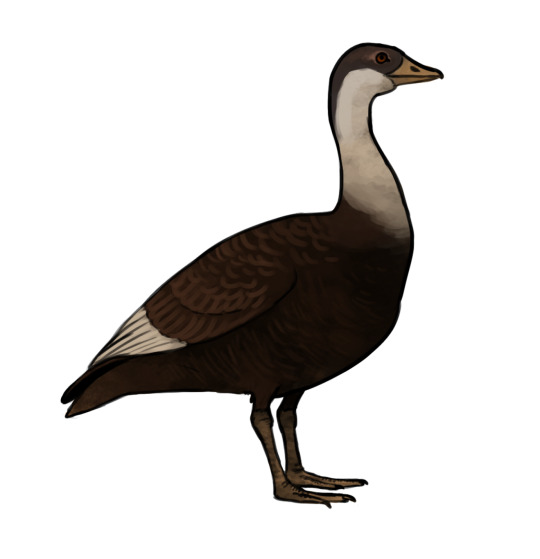
Vegavis, by @thewoodparable
We have four confirmed Neornithes from the Maastrichtian, the last age of the Cretaceous: three duck-like things (Vegavis, Teviornis, "Styginetta") and one chicken-like thing (Asteriornis). Everything else is too fragmentary at this time to determine if they are truly a Neornithine, or just closely related.
Now, the family tree of Neornithes, at least at the base, is very well defined: We know that ratites and tinamou diverged from all other birds first (forming the Palaeognathae group), leaving the rest in Neognathae. We know that Chickens and Ducks ("Fowl") diverged from the rest of birds next, in a group called Galloanserae, leaving the rest of birds in Neoaves.
Which means, theoretically, if there were duck-like and chicken-like things at the very end of the Cretaceous, there should also be:
early Palaeognaths (because if Neognathae exists, so do they)
early Neoavians (because of Galloanserae exists, so do they)
And we've got.... nothing. Nada. Zip.

Asteriornis by @otussketching
And, let's face it: three possible ducks and one possible chicken is not exactly great turn out from the Galloanserans either
This is what we call a "gap" in the Fossil Record - things we know should be there, but just... aren't.
There are many reasons for this - Neornithes have exceptionally delicate bones and don't fossilize well in general (hence the fun we have in the Cenozoic with all the scrappy material); they probably were quite rare as other forms of birdie dinosaurs were having their heyday; and they may have lived in locations where we have not sampled the fossils present particularly well (ie, the "global south")
Which means, yes, the missing fossils may be out there... or maybe not.
What we do know is:
at least one Palaeognath made it through
several duck-like things made it through
at least one chicken-like thing made it through
at least one Neoavian made it through
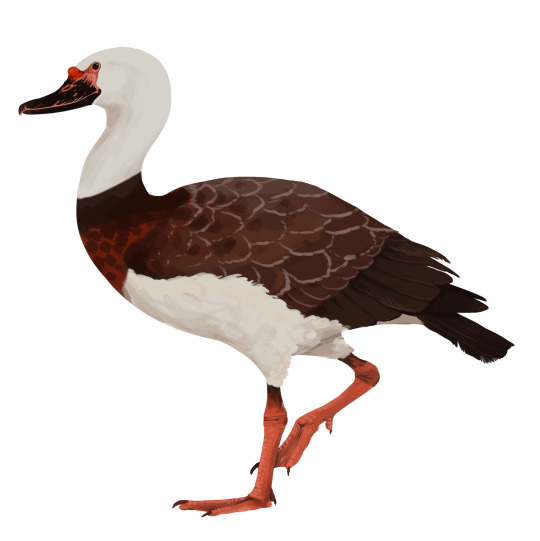
Teviornis, by @thewoodparable
In fact, "Styginetta" and Teviornis are, possibly, early members of the weird Presbyornithid group - a group of duck-like birds that lived as waders, leading to them being affectionately named "Flamingo-Ducks". This group was exceptionally common in the early Cenozoic, and lasted through the Miocene - and it first appeared in the Cretaceous!
Ducks are true apocalypse survivors - multiple groups of them crawled through to the other side!
These animals were, in every way, "modern-type" birds - no teeth in the beak, shortened tail bones, powerful wings for flight. But they were far removed from modern ducks and chickens, lacking many of their key features.
Such a small, seemingly insignificant group... and only they managed to survive. Wild stuff!
Sources:
Mayr, 2022. Paleogene Fossil Birds, 2nd Edition. Springer Cham.
Mayr, 2017. Avian Evolution: The Fossil Record of Birds and its Paleobiological Significance (TOPA Topics in Paleobiology). Wiley Blackwell.
Stidham, T.A. 2001. The origin and ecological diversification of modern birds: Evidence from the extinct wading ducks, Presbyornithidae (Neornithes: Anseriformes). University of California Berkely Dissertation.
141 notes
·
View notes
Photo

Brontornis burmeisteri was one of the largest flightless birds known to have ever existed, standing around 2.8m tall (9'2") and estimated to have weighed 400kg (~880lbs).
Known from the early and mid-Miocene of Argentina, between about 17 and 11 million years ago, it's traditionally considered to be one of the carnivorous terror birds that dominated predatory roles in South American ecosystems during the long Cenozoic isolation of the continent.
But Brontornis might not actually have been a terror bird at all – it may have instead been a giant cousin of ducks and geese.
The known fossil material is fragmentary enough that it's still hard to tell for certain, but there's some evidence that links it to the gastornithiformes, a group of huge herbivorous birds related to modern waterfowl.
If it was a gastornithiform, that would mean it represents a previously completely unknown lineage of South American giant flightless galloanserans. And, along with the gastornithids and the mihirungs, it would represent a third time that group of birds convergently evolved this sort of body plan and ecological role on entirely different continents during the Cenozoic.
———
Nix Illustration | Tumblr | Pillowfort | Twitter | Patreon
#science illustration#paleontology#paleoart#palaeoblr#brontornis#gastornithiformes#anserimorphae#odontoanserae#galloanserae#bird#dinosaur#art#convergent evolution#it's a lovely morning in the miocene and you are a giant horrible stem-goose#honk
559 notes
·
View notes
Photo
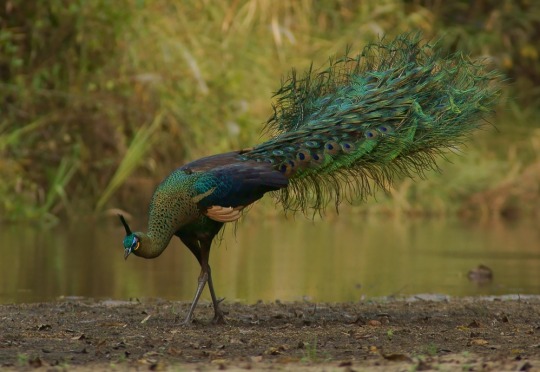
Green peafowl (Pavo muticus)
Photo by Christoph Keller
#green peafowl#peafowl#pavo muticus#pavo#pavonini#phasianinae#phasianidae#phasianoidea#galliformes#galloanserae#neognathae#aves#theropoda#archosauria#sauropsida#reptilia#tetrapoda#vertebrata#chordata
207 notes
·
View notes
Text
Every time I see someone make that dead joke about “Donald Duck eating turkey = cannibalism”, I feel an urge to doodle an alt universe where sapient birds are freaking out about “Hubie Human eating rabbit = cannibalism”.

#Animals#Birds#Ducks#Turkeys#Mammals#Rabbits#Donald Duck#Just a thought#Taxonomy#Euarchontoglires#Galloanserae
2 notes
·
View notes